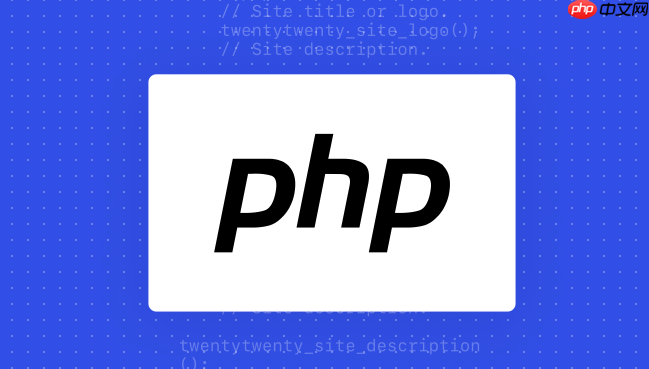 Backend Development
Backend Development
 PHP Tutorial
PHP Tutorial
 How to use PHP combined with AI to predict customer behavior PHP precise marketing data analysis
How to use PHP combined with AI to predict customer behavior PHP precise marketing data analysis
How to use PHP combined with AI to predict customer behavior PHP precise marketing data analysis
Jul 25, 2025 pm 06:27 PMPHP can efficiently collect and preprocess customer behavior data, obtain multi-source data through database query, log analysis and front-end buried points, and perform cleaning, conversion and feature engineering; 2. The most effective is to choose cloud AI services (such as AWS SageMaker, Google Cloud AI). Because its API is easy to integrate, maintain low maintenance costs and stable performance, it is suitable for PHP to call through HTTP; 3. PHP automatically triggers precise marketing actions based on AI prediction results, such as personalized recommendations, loss warning and retention, dynamic advertising delivery, and achieve closed-loop optimization through API linkage email, CRM and other tools, ultimately improving marketing efficiency and commercial value.

PHP is indeed well combined with AI for customer behavior prediction and precise marketing data analysis. The core lies in PHP, as a backend language, can efficiently collect and process data, and interact with various powerful AI services (whether it is a cloud API or a self-built model interface) through HTTP requests to obtain prediction results, and ultimately drive marketing automation. This is not a sci-fi out of reach, but a real implementation of technology.

To use PHP to achieve customer behavior prediction and precise marketing, we usually adopt a "division of labor and collaboration" strategy. PHP is responsible for the inlet and outlet of data flow, while AI assumes the role of "brain".
First, PHP will gather customer data from various channels, which may include website access logs, purchase records, email interactions, and even customer portraits in the CRM system. These raw data are often scattered, and PHP needs to perform preliminary cleaning and structure here, such as unifying data from different sources, eliminating duplicates, or converting timestamps into analytical dimensions. I personally think that the quality of this step directly determines the upper limit of subsequent AI analysis, and no matter how good the model is, it cannot extract "gold" from "garbage".

Then, these preprocessed data will be packaged by PHP, usually in JSON format, and sent to the AI service via HTTP/HTTPS requests. This AI service can be mature cloud platforms such as Google Cloud AI, AWS SageMaker, Azure Machine Learning, etc. They provide pre-trained models or allow us to deploy custom models. Of course, if you have a dedicated AI team, they may build complex prediction models in languages such as Python and expose them through RESTful APIs, PHP can also send data and receive prediction results by calling these APIs.
After receiving the AI prediction results, such as the probability of a customer churn, the next product you may purchase, or the possibility of responding to a marketing campaign, PHP will trigger specific marketing actions based on these insights. This could be to automatically send a personalized recommendation email, dynamically display customized products when users visit the website, or adjust ad delivery strategies. The entire process can be designed as an automated assembly line, greatly improving marketing efficiency and accuracy.

How does PHP obtain and preprocess customer behavior data?
In the world of PHP, obtaining customer behavior data is actually our old business. This usually involves several core links, and frankly, real-world data is much more chaotic than what is shown in the tutorial.
The most common source is databases, such as MySQL or PostgreSQL. User registration information, purchase history, order details are all structured treasures. PHP can easily query and extract this data through PDO or ORM (such as Laravel's Eloquent). But that's not enough.
Access logs for websites are another gold mine, although they usually exist in text form and can be a bit troublesome to parse. PHP can read these log files and extract IP address, access time, request URL, user agent and other information through regular expressions or more professional log parsing libraries. This data can help us understand the user's browsing paths and points of interest.
In addition, there are also data buried. User clicks, scrolling, dwell time and other behaviors collected on the front end through JavaScript are usually sent to the PHP backend through AJAX requests, and PHP is then responsible for writing this data to the database or message queue (such as RabbitMQ, Kafka). This is the key to acquiring user microbehavior.
During the preprocessing stage, PHP's task is to turn these "raw meat" into "delicious food". This includes:
- Data cleaning: Remove invalid or duplicate records, process missing values (such as filling with default values, or discarding them directly). What I often encounter is that some fields are stored in unexpected formats because the front-end verification is not rigorous, and PHP needs to correct them.
- Data conversion: Convert raw data into a format that the AI model can understand. For example, converting timestamps to date or day of the week, encoding classified text data into numbers (such as "male" -> 1, "female" -> 0), or normalizing consecutive numerical values (Min-Max Scaling or Z-score normalization), can prevent some features from taking up too much weight in the model.
- Feature Engineering: This is the more advanced part, but PHP can also participate. For example, calculate the "purchase interval" based on the user's purchase frequency, and calculate the "activeness" based on the number of pages visited. These newly generated features tend to reflect deep patterns of customer behavior better than the original data.
In short, PHP is like an efficient "data steward" here, ensuring that the ingredients sent to the AI "kitchen" are clean, neat and available.
Which AI service is most effective to choose to integrate with PHP for behavior prediction?
When choosing an AI service, to be honest, there is no one-size-fits-all answer, which depends entirely on your specific needs, budget and team's technology stack. But from the perspective of PHP integration, cloud service API is often the most convenient and efficient choice.
Cloud AI services (such as Google Cloud AI, AWS AI/SageMaker, Azure Machine Learning): This is my personal most recommended path. These platforms provide mature, pre-trained models, or make it easy to deploy custom models and expose them through a simple RESTful API. PHP only needs to use an HTTP client (such as Guzzle or built-in curl extension) to send data to these APIs and then parse the returned JSON.
- Advantages: The deployment and maintenance cost is low, and there is no need to care about the underlying infrastructure. The model performance is usually guaranteed and scalable. Many services also come with data preprocessing and model management functions. For example, AWS Personalize is very good at recommendation systems and user behavior prediction.
- Disadvantages: Fees may increase with the increase in data volume and frequency of call, and companies with high requirements for data privacy may need to consider data outbound issues.
Build your own AI model and expose it through APIs (usually using Python frameworks such as Flask/FastAPI): If your team has dedicated machine learning engineers, they may use Python (TensorFlow, PyTorch, Scikit-learn) to train highly customized models. To make PHP call, these models are usually encapsulated into a web service (such as built with Flask or FastAPI) to provide prediction capabilities to the outside world through the HTTP API.
- Advantages: Extreme customization can accurately meet business needs, and the data is completely in your own hands.
- Disadvantages: The maintenance cost is high, and a professional ML Ops team is required to deploy, monitor and iterate the model, which has high requirements for server resources. The role PHP plays here is still an API caller, but it needs to work closely with the Python team.
PHP local ML libraries (such as PHP-ML, Rubix ML): Although the PHP community also has some machine learning libraries, they are usually more suitable for traditional machine learning algorithms, such as classification, regression, clustering, etc. For deep learning and complex large-scale behavior prediction, their performance and ecosystem are far inferior to Python or specialized cloud services.
- Advantages: Pure PHP implementation, no external dependencies are required.
- Disadvantages: Limited functions, not suitable for handling large data volumes and complex AI tasks, and the community activity is relatively low. I generally do not recommend using this solution to make core customer behavior predictions.
Overall, for most PHP projects, leveraging mature cloud AI services is the highest input-output ratio option. It allows you to go online quickly and focus on business logic and data integration that PHP is good at.
How does PHP use AI prediction results to achieve precise marketing automation?
When the AI model gives the prediction results, PHP's task is to transform these "intelligence" into actual "actions", and they are automated and precise actions. This is like an intelligent command center that schedules various marketing resources according to the instructions of AI.
The most direct application is personalized recommendations . If the AI predicts that a user is most likely to purchase A product, PHP can immediately display A product for that user on the website, or send an email with product recommendations through a mail system (such as an API that integrates Mailchimp or SendGrid). This kind of dynamic content generation and email triggering is very easy to handle.
For example, customer churn warning . The AI model predicts that a customer has a high risk of churn, and PHP can immediately trigger a "retention plan": for example, sending an exclusive coupon to the customer, or reminding the customer service staff to contact him actively. These can all be achieved through scripts or services written by PHP. Cron jobs play an important role here, regularly checking AI's prediction reports and performing corresponding actions.
Dynamic advertising delivery is also a good example. AI predicts that a certain customer is more responsive to a certain type of advertisement, and PHP can synchronize this tag to an advertising platform (such as Google Ads API and Facebook Marketing API) to achieve more accurate audience positioning and avoid invalid advertising.
In addition, there are price optimization and inventory management . If AI predicts that a certain product will surge in demand during a certain period of time, PHP can adjust the price of the product or remind the inventory management system to prepare stocks in advance. Although this is not directly marketing, it is closely related to marketing effectiveness.
To implement these automations, PHP usually:
- Analyzing AI responses: The result returned by AI services is usually in JSON format, which PHP needs to parse into an operable data structure.
- Conditional judgment and logic triggering: PHP will execute different business logic based on the threshold or type of the predicted result. For example, if the probability of churn is greater than 80%, the retained email is triggered; if it is less than 20%, it is marked as low risk.
- API call: Call the API of external marketing tools (mail service, SMS platform, CRM, advertising platform, etc.) to perform specific marketing actions.
- Data recording and feedback: Record the results of each marketing action and user feedback (such as email opening rate, click-through rate, and conversion rate). These data can be used as new training data to form a closed loop and continuously optimize AI models and marketing strategies.
The whole process emphasizes "automation" and "precision". PHP plays a key executor role here, transforming the intelligence of AI into visible business value. This is not achieved overnight, and it often requires continuous iteration and optimization, but the rewards it brings are obvious.
The above is the detailed content of How to use PHP combined with AI to predict customer behavior PHP precise marketing data analysis. For more information, please follow other related articles on the PHP Chinese website!

Hot AI Tools

Undress AI Tool
Undress images for free

Undresser.AI Undress
AI-powered app for creating realistic nude photos

AI Clothes Remover
Online AI tool for removing clothes from photos.

Clothoff.io
AI clothes remover

Video Face Swap
Swap faces in any video effortlessly with our completely free AI face swap tool!

Hot Article

Hot Tools

Notepad++7.3.1
Easy-to-use and free code editor

SublimeText3 Chinese version
Chinese version, very easy to use

Zend Studio 13.0.1
Powerful PHP integrated development environment

Dreamweaver CS6
Visual web development tools

SublimeText3 Mac version
God-level code editing software (SublimeText3)
 btc trading platform latest version app download 5.0.5 btc trading platform official website APP download link
Aug 01, 2025 pm 11:30 PM
btc trading platform latest version app download 5.0.5 btc trading platform official website APP download link
Aug 01, 2025 pm 11:30 PM
1. First, ensure that the device network is stable and has sufficient storage space; 2. Download it through the official download address [adid]fbd7939d674997cdb4692d34de8633c4[/adid]; 3. Complete the installation according to the device prompts, and the official channel is safe and reliable; 4. After the installation is completed, you can experience professional trading services comparable to HTX and Ouyi platforms; the new version 5.0.5 feature highlights include: 1. Optimize the user interface, and the operation is more intuitive and convenient; 2. Improve transaction performance and reduce delays and slippages; 3. Enhance security protection and adopt advanced encryption technology; 4. Add a variety of new technical analysis chart tools; pay attention to: 1. Properly keep the account password to avoid logging in on public devices; 2.
 How to implement a referral system in Laravel?
Aug 02, 2025 am 06:55 AM
How to implement a referral system in Laravel?
Aug 02, 2025 am 06:55 AM
Create referrals table to record recommendation relationships, including referrals, referrals, recommendation codes and usage time; 2. Define belongsToMany and hasMany relationships in the User model to manage recommendation data; 3. Generate a unique recommendation code when registering (can be implemented through model events); 4. Capture the recommendation code by querying parameters during registration, establish a recommendation relationship after verification and prevent self-recommendation; 5. Trigger the reward mechanism when recommended users complete the specified behavior (subscription order); 6. Generate shareable recommendation links, and use Laravel signature URLs to enhance security; 7. Display recommendation statistics on the dashboard, such as the total number of recommendations and converted numbers; it is necessary to ensure database constraints, sessions or cookies are persisted,
 USDT virtual currency account activation guide USDT digital asset registration tutorial
Aug 01, 2025 pm 11:36 PM
USDT virtual currency account activation guide USDT digital asset registration tutorial
Aug 01, 2025 pm 11:36 PM
First, choose a reputable digital asset platform. 1. Recommend mainstream platforms such as Binance, Ouyi, Huobi, Damen Exchange; 2. Visit the official website and click "Register", use your email or mobile phone number and set a high-strength password; 3. Complete email or mobile phone verification code verification; 4. After logging in, perform identity verification (KYC), submit identity proof documents and complete facial recognition; 5. Enable two-factor identity verification (2FA), set an independent fund password, and regularly check the login record to ensure the security of the account, and finally successfully open and manage the USDT virtual currency account.
 USDT virtual currency purchase process USDT transaction detailed complete guide
Aug 01, 2025 pm 11:33 PM
USDT virtual currency purchase process USDT transaction detailed complete guide
Aug 01, 2025 pm 11:33 PM
First, choose a reputable trading platform such as Binance, Ouyi, Huobi or Damen Exchange; 1. Register an account and set a strong password; 2. Complete identity verification (KYC) and submit real documents; 3. Select the appropriate merchant to purchase USDT and complete payment through C2C transactions; 4. Enable two-factor identity verification, set a capital password and regularly check account activities to ensure security. The entire process needs to be operated on the official platform to prevent phishing, and finally complete the purchase and security management of USDT.
 Ouyi app download and trading website Ouyi exchange app official version v6.129.0 download website
Aug 01, 2025 pm 11:27 PM
Ouyi app download and trading website Ouyi exchange app official version v6.129.0 download website
Aug 01, 2025 pm 11:27 PM
Ouyi APP is a professional digital asset service platform dedicated to providing global users with a safe, stable and efficient trading experience. This article will introduce in detail the download method and core functions of its official version v6.129.0 to help users get started quickly. This version has been fully upgraded in terms of user experience, transaction performance and security, aiming to meet the diverse needs of users at different levels, allowing users to easily manage and trade their digital assets.
 Ouyi · Official website registration portal | Support Chinese APP download and real-name authentication
Aug 01, 2025 pm 11:18 PM
Ouyi · Official website registration portal | Support Chinese APP download and real-name authentication
Aug 01, 2025 pm 11:18 PM
The Ouyi platform provides safe and convenient digital asset services, and users can complete downloads, registrations and certifications through official channels. 1. Obtain the application through official websites such as HTX or Binance, and enter the official address to download the corresponding version; 2. Select Apple or Android version according to the device, ignore the system security reminder and complete the installation; 3. Register with email or mobile phone number, set a strong password and enter the verification code to complete the verification; 4. After logging in, enter the personal center for real-name authentication, select the authentication level, upload the ID card and complete facial recognition; 5. After passing the review, you can use the core functions of the platform, including diversified digital asset trading, intuitive trading interface, multiple security protection and all-weather customer service support, and fully start the journey of digital asset management.
 Apple download Ouyi Exchange Ouyi official website download app exchange · (Apple version) official website
Aug 01, 2025 pm 11:24 PM
Apple download Ouyi Exchange Ouyi official website download app exchange · (Apple version) official website
Aug 01, 2025 pm 11:24 PM
Ouyi Exchange is a professional digital asset service application for global users, providing users with a safe, stable and feature-rich trading experience. Its official Apple version application is designed with smooth operation, aiming to help users easily manage and trade various digital assets and keep abreast of market trends at any time. Through the official website download and installation, users can enjoy the full range of services provided by the platform.
 How to share data between multiple processes in Python?
Aug 02, 2025 pm 01:15 PM
How to share data between multiple processes in Python?
Aug 02, 2025 pm 01:15 PM
Use multiprocessing.Queue to safely pass data between multiple processes, suitable for scenarios of multiple producers and consumers; 2. Use multiprocessing.Pipe to achieve bidirectional high-speed communication between two processes, but only for two-point connections; 3. Use Value and Array to store simple data types in shared memory, and need to be used with Lock to avoid competition conditions; 4. Use Manager to share complex data structures such as lists and dictionaries, which are highly flexible but have low performance, and are suitable for scenarios with complex shared states; appropriate methods should be selected based on data size, performance requirements and complexity. Queue and Manager are most suitable for beginners.





